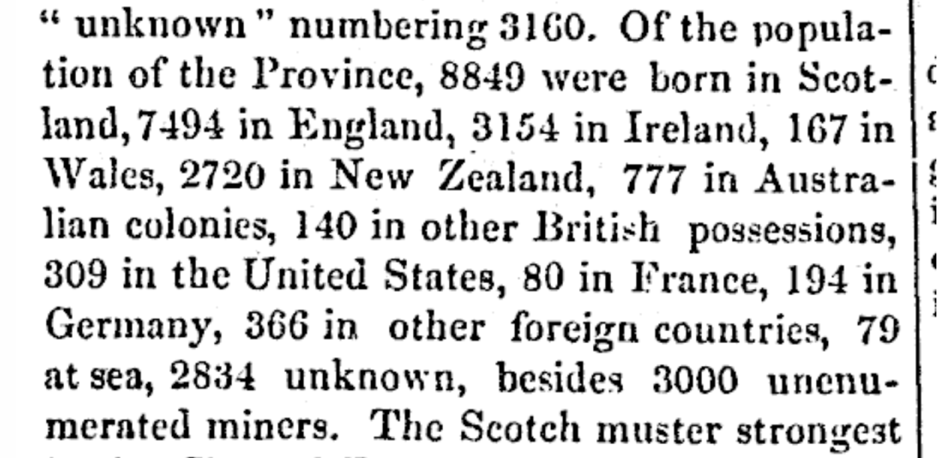Part of our work in the historic cemeteries has involved looking at where people came to Otago from during the early colonial period. You might not think we need to do this – surely we have ship’s records and censuses that tell us all about who was in New Zealand and where they came from – right?
Well, kind of. We do have records of who was on European ships coming to New Zealand. But those records are often woefully incomplete. They’ll tell you where people boarded the ship, but not where they were originally from. Even if we do have hints of people’s origins, we often don’t have their full stories. Some of those who came to New Zealand came to escape stigma or poor conditions at home, they didn’t want to remember where they came from and they didn’t talk about their life before arriving in New Zealand…
If our knowledge of the European colonists is sketchy, our understanding of more marginalised groups like the Chinese miners who came in the 1860s and 70s is much worse. There are very few written records relating to Chinese communities in New Zealand, and we tend to make assumptions that most if not all Chinese miners in New Zealand were part of the same clan groups from rural Southern China (Guangdong province).

That’s where looking at the biological evidence for ancestry and origins can help us. These people might not have talked much about where they came from, but clues are hidden in their DNA and the chemistry of their bones and teeth. And using a little bit of scientific analysis we can tease out who these people were. So Prof. Lisa Matisoo-Smith (our resident DNA expert) and myself (Dr. Charlotte King – a bone/tooth chemistry expert) combined our powers to look at who was on the goldfields, and how multicultural life there really was.
Some of our findings are as you’d expect. Those buried in the European Ardrossan Street cemetery of Lawrence have European DNA signatures (haplogroups), and tooth chemistry that is consistent with places across the UK, Ireland and parts of Europe. We do, however, have one intriguing person buried at Ardrossan Street who has a chemical signal that is more consistent with Chinese origins and was buried with rice in their grave. Sadly this person did not have DNA preserved for us to confirm whether they did have Chinese ancestry – the burial conditions don’t always allow us to do all the analysis we’d like to. For us this is particularly interesting because Ardrossan Street cemetery closed before any Chinese migrants are recorded in Otago, so this person might represent one of the very earliest (unrecorded) Chinese arrivals.

And, just as you’d expect, most of those buried in the ‘Chinese’ section of the slightly later Gabriels St cemetery have DNA signatures which show they were of Asian ancestry, and tooth chemistry consistent with origins in the old granitic areas of Southern China. Most, but not all. In fact, one of the most interesting discoveries we made in this part of the project is that the Chinese community actually seems to be relatively diverse!
Four people had very similar chemical signatures which match well with Guangdong province (where we assume most Chinese sojourners came from during this period). One person has isotopic values that also align with Southern China, but not the Guangdong region, and three others have chemical signatures that are too low for Southern China. One of these people has a mitochondrial DNA haplogroup that is most common in Southeast Asia, and possibly had origins outside of China. The other two have no ‘Chinese’ associated items in their burials, and it’s possible that they weren’t Chinese at all, but instead European people who were buried alongside the Chinese either through choosing to associate with them, or through poverty restricting where they could be buried.

And on top of this diversity we found one person whose DNA, burial goods and chemical signals show that their cultural identity was very complicated indeed! The first burial we excavated from Gabriels St (G1) was buried with a burnt offering, and wore clothes typical of the Chinese miners of the time. His chemical signature matches well with other Chinese migrants in the cemetery who came from Guangdong. So far typical of what we know of the Chinese mining population… but the DNA results show he had European maternal ancestry! We can’t say whether this is recent ancestry (i.e. his mother was European) or way back in his family’s past … but this one person shows us that we can’t put the people of the goldfields into neat little boxes.
So what have we learned that’s new? Well, hopefully we’ve shown that the popular image of British miners doing it tough on the goldfields isn’t the whole story. Interaction between cultures was the norm on the colonial frontier, whether that be between the diverse groups of Europeans present, between different Chinese groups, or between the Chinese miners and their European counterparts. The goldfields were a melting pot, and modern multicultural New Zealand has its roots there.
Charlotte King, July 2021
Find out more:
This work has recently been published in the Journal of Archaeological Science:
King C.L., Buckley H.R., Petchey P., Roberts P., Zech J., Kinaston R.L., Collins, C., Kardailsky, O., Matisoo-Smith, E., Nowell, G. 2021. An Isotopic and Genetic Study of Multi-Cultural Colonial New Zealand. Journal of Archaeological Science. 128: 105337.
And featured on RNZ’s Afternoon’s with Jesse Mulligan: https://www.rnz.co.nz/national/programmes/afternoons/audio/2018790906/early-gold-mine-settlers-a-melting-pot-of-cultures
Really interesting .
Great work. Keep it up.
Fyi, a Finch relie of mine 1st Cousin 3 times removed
1873
LikeLike